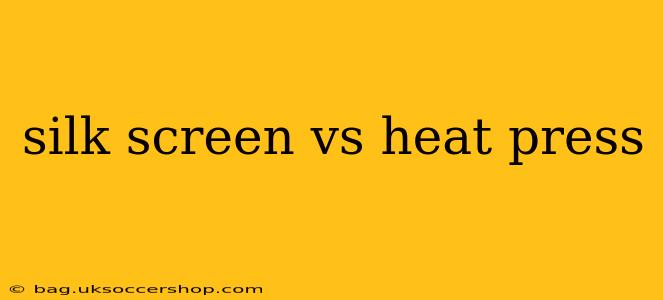Choosing the right printing method for your project can feel overwhelming. Two popular choices often top the list: silk screen printing and heat transfer printing. Both offer unique advantages, making the decision depend heavily on factors like budget, design complexity, and the quantity of items you need to print. This comprehensive guide will break down the key differences, helping you determine which method best suits your needs.
What is Silk Screen Printing?
Silk screen printing, also known as screen printing, is a time-tested method that involves pushing ink through a mesh stencil onto a substrate (like fabric, paper, or wood). Each color requires a separate screen, making it ideal for projects with bold, simple designs. The process is known for producing vibrant, long-lasting prints with a thick, tactile feel.
Advantages of Silk Screen Printing:
- Durability: Silk screen prints are exceptionally durable and resistant to fading and cracking, even after numerous washes (for garments).
- Vibrant Colors: The thick ink layer produces rich, saturated colors.
- Large-Scale Production: It's highly efficient for printing large quantities, making it cost-effective for bulk orders.
- Texture: The ink provides a raised, textured feel, adding a unique aesthetic.
Disadvantages of Silk Screen Printing:
- Setup Costs: Creating the screens can be expensive, making it less cost-effective for small print runs.
- Design Limitations: Complex designs with fine details or many colors can be challenging and costly to reproduce accurately.
- Longer Production Time: The setup and printing process takes longer compared to heat transfer printing.
What is Heat Transfer Printing?
Heat transfer printing uses heat to transfer an image printed on special transfer paper onto a substrate. The image is printed using an inkjet or laser printer, then pressed onto the material with a heat press machine. This method is versatile and can handle intricate designs with multiple colors effortlessly.
Advantages of Heat Transfer Printing:
- Cost-Effective for Small Runs: Setup costs are minimal, making it ideal for small print runs or prototypes.
- Design Versatility: Handles complex designs with ease, including fine details and gradients.
- Fast Production Time: The printing and transfer process is relatively quick.
- Wide Range of Substrates: Applicable to various materials including fabric, wood, metal, and more.
Disadvantages of Heat Transfer Printing:
- Lesser Durability: Heat transfers are generally less durable than screen prints, prone to peeling or fading with repeated washing (for garments).
- Image Quality: While capable of intricate designs, the print quality might not be as sharp or vibrant as silk screen printing, especially with dark colors.
- Limited Texture: Prints tend to have a flatter, less textured feel.
- Not Ideal for Large Runs: The cost per item may increase significantly as the quantity rises.
Silk Screen Printing vs. Heat Transfer Printing: Which is Better for My Project?
The "better" method hinges entirely on your specific project requirements:
- Choose Silk Screen Printing if: You need a highly durable, vibrant print with a textured feel, require a large print run, and your design is relatively simple.
- Choose Heat Transfer Printing if: You need a cost-effective solution for a small print run, your design is complex with many colors and details, and you need a fast turnaround time.
What is the Cost Difference Between Silk Screen Printing and Heat Transfer Printing?
The cost difference varies drastically based on several factors. For small orders, heat transfer printing is typically cheaper. However, for larger quantities, the cost per unit for silk screen printing often drops significantly, potentially becoming more economical than heat transfer. Always obtain quotes from multiple printers to compare pricing accurately.
Which Printing Method is More Durable?
Silk screen printing consistently produces more durable prints. The ink penetrates the fabric fibers, leading to superior longevity and resistance to washing and abrasion compared to heat transfer prints, which sit on the surface of the material.
Which Printing Method is Best for Dark-Colored Fabrics?
Both methods can work on dark fabrics, but each presents challenges. Silk screen printing generally produces brighter, more vibrant colors on dark fabrics. However, specialized inks and techniques might be needed for both methods to achieve optimal results.
Which Method is Faster?
Heat transfer printing boasts a significantly faster turnaround time, primarily due to its lower setup requirements. Silk screen printing involves screen creation, which adds considerable time to the production process.
By carefully weighing these factors and considering your budget, design complexity, and desired quantity, you can confidently choose the best printing method for your next project. Remember to always get quotes from different print shops to compare prices and production timelines.
